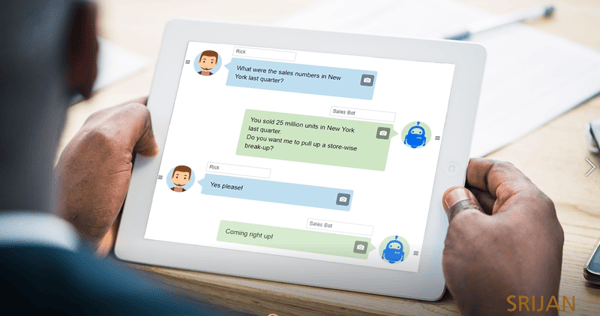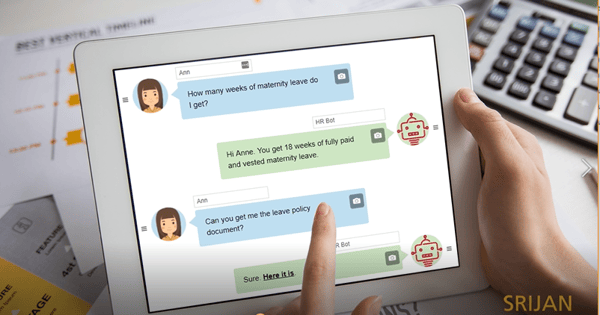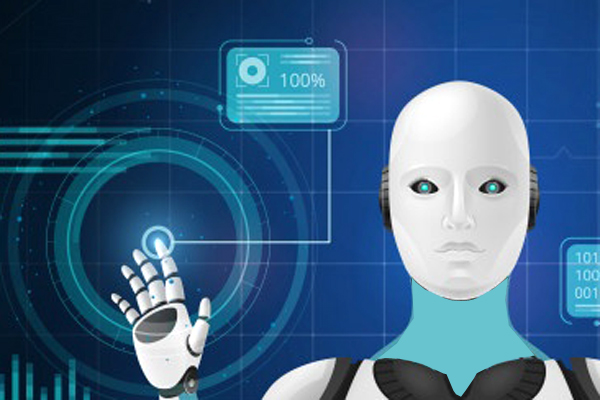Over the last few years, the mobile application was a must-have piece in the market strategy for both start-ups and incumbents. And while it’s still essential, there’s a definite paradigm shift happening from applications to chatbots.
By 2020:
- Over 80% of businesses are expected of have chatbots implemented in some form
- More than 50% or enterprises will be spending significantly more per-annum on bot development as compared to traditional mobile-apps
- Enterprises, especially in the banking and healthcare sectors, are estimated to have an average 8 billion USD in savings with the adoption of chatbots
A large part of the discussion around chatbots is focussed on how these automated conversational interfaces can enhance the customer experience for brands. They can ensure a 24x7 responsive customer service that solve customer issues, guide customers to conversion, up-sell products and services based on the context.
.png?width=600&name=Chatbot%20(1).png)
However, the impact of chatbots extends well beyond customer interactions. There are a host of enterprise processes and operations that can be streamlined with the introduction of bots. A few key use-cases for enterprise chatbot across industries would be:
Business Intelligence
About 70-80% of enterprise BI projects fail, and a key reason for that is low adoption rates. BI software today, while extremely powerful, are not really easy to master. While there is a lot of in-depth analysis that can be done on your dashboard, does every stakeholder know how to extract the data they want? Probably not. And hence the low usage rates.
Moreover, attention spans are short and executive do not have a lot of time on their hands to manipulate report dashboards to get the insights they want. They are seeking answers to very specific questions, and want the answers in real time.

With bots as an interface between the BI software and stakeholders, access to information can be simplified. You can simply ask the bot “What were the sales numbers in New York last quarter?”, and you will have an answer. No more filters to apply, no date-ranges to select, no login to the dashboard. Such access to data is extremely valuable for busy executives and allow them to focus on their core work.
These enterprise chatbots can be designed and trained to answer increasingly complex questions. And generate relevant insights and action items for the user, based on the question they ask. They can fit into a variety of business applications that channel data, like IoT systems, marketing automation dashboards, sales reports, operational portals and more. This kind of asked-and-answered approach makes it easy for everyone on the team to leverage these BI software or other data sources to their full potential, and actually practice data-driven decision making.
Bots for the Developer
This one might be specific to technology or product companies, and is one of the most pertinent uses cases for adopting bots within your enterprise.
Collaboration and communication is a cornerstone of DevOps, and chat platforms like Slack are the place where this collaboration is happening. However, this collaboration can be further improved when chat platforms become the new command center of sorts. This means your teams no longer just receive an alert or issue on the chat platform, but can actually perform fixes without leaving the platform. They can command a bot, by simply typing into the chat platform, and the necessary action/fix will be performed by the bot. Bots can also independently identify issues, handle escalations, and prompt necessary action items to the right team members.
This is ChatOps, where bots like Hubot, Lita, or Errbot help monitor and orchestrate the delivery pipeline with intelligent coordination and execution capabilities.These bots can be designed and tweaked to suit your particular scenarios and workflows, and can take over a significant amount of mundane monitoring, alerts, issue prioritization, and even simple fixes like start/stop environments, and rollbacks and roll-forwards.
Human Resource Management
Enterprise HR teams have a bunch of repeated tasks and processes that can be automated with bots.
Access to Information
One of the most prominent areas would be easy access to all company policy documentation. Instead of having to personally ask HR executives, employees simply put their questions to a bot built specifically for this. The bot can direct people to the right documents that would sufficiently answer their question. This means quick access to information, with time saved all around.

Employee Onboarding
Instead of the HR team being personally involved in onboarding employees or freelance staff, bots can guide them through the process. The complete process is built into the logic of the bot and it can lead new hires through a series of questions, task completions, and other helpful videos and documents to complete onboarding.
Micro-learning
Similar to onboarding, employee training and professional education courses are also a great application for chatbots. Instead of a set of dry course material and videos, the bots can make the process more interactive. Increasing the complexity of these bots, to incorporate AI, would give them the ability to run micro-learning courses at a pace that is customized to the capabilities of each employee.
Employee Data-Gathering
Currently, HR rolls out surveys that ask a number of questions, via email. And more often than not, these go unfilled. A well-designed bot can make the process more immediate and interactive, giving better chances of collecting meaningful data. Also, given the existing interactions between bots and employees, there’ll also be a lot of immediate employee data points available by analyzing these interactions.
Other HR operations like travel and ticketing, time-logs, tracking leaves, and reporting can all be simplified with specialized enterprise chatbots. Field teams dispersed across geographies can also resolve common operational queries, easily access data on the go, and complete and update tasks remotely; via interactions with chatbots.
Intra-organization Communications
Working in teams means a huge amount of time being spent in coordinating with the team members. And this coordination can now be automated, with chatbots working as virtual assistants for each employee. You simply have to ask a chatbot to set up a meeting for you. Accessing someone’s calendar, looking for a free time-slot, scheduling the meeting, adding reminders etc. is then completed by chatbots talking to each other.
Similarly, company-wide updates, access to current news and events, and a host of other essential but repetitive communications required between teams can be handled efficiently by chatbots.
The core benefits of introducing chatbots into enterprise operations, are the same as customer-facing bots:
- Anytime, anywhere access to required information
- Free up valuable resources from mundane tasks
- Simplify and accelerate the execution of a number of tasks
- Save time and money
Once the diverse use cases and possibilities are understood, the next step for enterprises is to identify exactly which of their processes can be supplemented by chatbots. Enterprise teams will also have to decide between using available platforms for building their bots or building one from scratch, the natural language processing (NLP) engines to be used, designing the bot logic and decision trees, and training bots to perform at scale. There’s also the aspect of measuring the efficacy of these bots, and zero in on the exact metrics to be monitored to track bot performance.
While this might look like a lot to go through before getting started with chatbots, let’s take it one step at a time.
What is the one business process at your enterprise that can be handled by chatbots?
Srijan's enterprise chatbot development services can help take your chatbots from concept to implementation. Book a meeting with our Chatbot experts to explore exactly how we can make that happen.
Our Services
Customer Experience Management
- Content Management
- Marketing Automation
- Mobile Application Development
- Drupal Support and Maintanence
Enterprise Modernization, Platforms & Cloud
- Modernization Strategy
- API Management & Developer Portals
- Hybrid Cloud & Cloud Native Platforms
- Site Reliability Engineering




